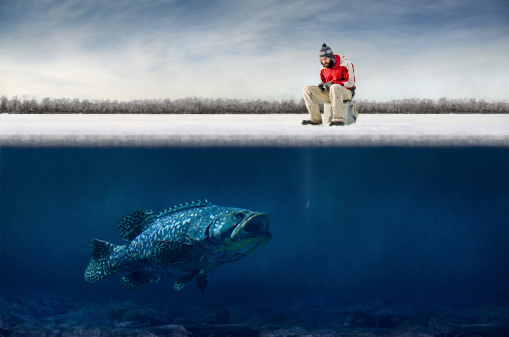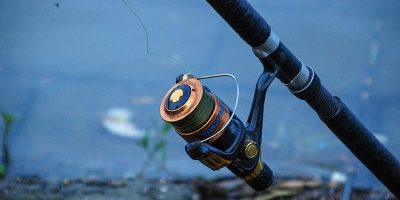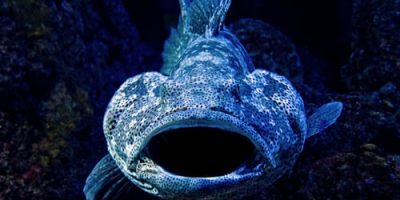As ice fishermen set up their shacks, dig holes, and search for life beneath the ice, the frozen Iowa Great Lakes are dotted with blue and black. And there’s plenty of species to be discovered, but how do fish live in such harsh conditions? You can study how ice forms on lakes and why it doesn’t ice to the ground here, and then return here to understand how fish survive beneath the massive ice sheets. In this blog you will know how do fish survive in cold water.
Cold-blooded
Fishes are cold-blooded, implying their body temperature varies according to their surroundings. Humans keep a constant body temperature, whereas cold-blooded species like snakes, turtles, and fish survive in cold water, adjust to their circumstances.
Obtaining food
Perch, crappies, bluegills, and trout are among the species that can raise their body temp even in ice water, but they should consume enough to do so. Other fish, such as catfish, carp, and bass, will eat enough for the summer and fall to gain enough fat to help them survive the winter, similar to how bears eat a lot before hibernating.
Crappies, pumpkinseeds, perch, and bluegills will be on the lookout for easy prey, such as aquatic bug immature larvae in the dirt at the base of ponds and lakes. Northern pike and bluegill lose weight within winter because they can’t locate enough food to compensate for the calories they expend to stay alive.
Taking it easy
Fish consume less in the winter because their body functions slow down and eat less. Prey fish will congregate in natural vegetation where they may both hide and eat. Predator fish will then swim slowly by these spots, searching for a quick and easy meal. Catfish will occasionally bury themselves in the mud and wait for spring to arrive.
Staying stationary until it’s time to eat may appear to be the most efficient approach to conserve energy. But fish survive in cold water and must move enough for water to pass over their gills to breathe.
There’s enough oxygen
Fish kills can occur in shallow lakes that have frozen almost to the bottom due to a lack of oxygen in the water.
Ice prevents water from sharing oxygen with air and hinders light that enables plants and phytoplankton to develop and produce oxygen from the water. During the winter, oxygen levels gradually decrease.
However, because colder water can store more absorbed gas than warmer water, the oxygen content of water below freezing is the highest. The fish then need less oxygen since their metabolism has slowed. Some fish even enter a state known as torpor, which reduces their requirement for oxygen even further.
The same as before
In general, life in the freezing lakes in the winter is very similar to life in the summer, albeit considerably slower and less vegetation.
How do fish cope with the cold?
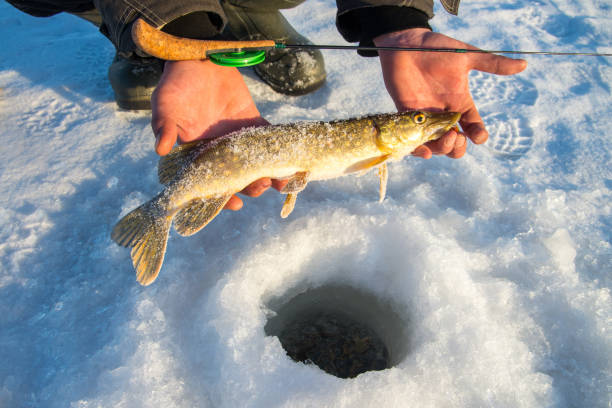
For starters, because of one of water’s most unusual qualities, freshwater fish are rarely endangered by dying of frostbite. Water, like other things, becomes denser as the weather cools. However, it is densest just above freezing; between 4° and 0°, density increases, forcing ice to sail. Out from bottom-up approach, rivers and lakes will freeze if it weren’t for this feature, and fish survive in cold water in seasonal extinction would occur in northern latitudes.
However, not all fish are similarly thermally acclimated, and numerous cannot endure extremes of cold or heat. Thermal tolerances are crucial determinant of fish ranges. However, fish survive in cold water and have adapted to cope with frigid temperatures in a variety of ways within their range:
Movement
Multiple fish create seasonal migrations for thermal refugia when the temperatures drop. In northern climates, where warmer deep water helps preserve ice-free freshwater habitats, thermal refugia can be especially significant.
Enzymes that work differently
Enzymes are biological catalysts for metabolism, but their effectiveness is temperature-dependent. It functions best at a specific temperature. Other fishes have become alternate enzyme systems named isozymes to execute the same job at different ideal temperatures to enhance their effectiveness across various temperatures. Further fishes use allozymes, multiple conditions of the identical enzyme controlled by distinct alleles, allowing processes to operate at diverse temperatures.
Antifreeze
High salt concentrations in polar aquatic systems lower the freezing point of water to roughly -2°, which is colder than most freezing temperatures of species’ body fluids. Antifreeze proteins prevent blood from crystallizing in these settings, and numerous species contain them. They can survive in the harsh, ice-covered arctic areas because of this.
The concentration of salt. Other animals outsmarted the super-cold, salty water. To maintain an osmotic balance, marine fishes must constantly export ions. On the other hand, retaining more ions can help a fish lower its freezing point and live in sub-zero temperatures.
But, in the end, some fish cannot withstand the cold. Threadfin Shad, in particular, are prone to massive winter die-offs, which can be a valuable source of winter feed for a variety of predators. Extreme temperature swings are a common cause of large-scale winter fish deaths. In 2011, for example, 100,000 drums died in the Arkansas River after an unusually cold storm passed through after several weeks of mild weather.
Finally, many ponds and small lakes suffer from winterkill, a mass fish death caused by ice that prevents oxygen exchange. The fish in the image above most likely suffocated and floated to the surface, where they became encrusted with ice.
Is it true that fish get cold? How Do Fish Survive During the Winter?
If you’ve ever gone ice fishing or been trapped out in the rain, you know how cold water can get in the winter. It’s hard not to marvel at how anything can survive in such harsh environments as lakes and freezing oceans. Is it true that fish get cold? How do they make it through the winter? These are some of the most frequently asked questions at this time of year, so here are the answers.
Is it true that fish get cold?
Yes, fish are pretty sensitive to temperature variations in the water. They’re so keen that even a few degrees of difference can kill them. Fish get chilly, but what “cold” means to them is unclear.
Every fish species has a preferred temperature range. However, it differs greatly depending on their origins. At 75°F, a tropical Lionfish may begin to shiver, whilst a Northern Pike may suffer from heatstroke. Both of these guys are tough as nails; they’re just built for different environments.
How do fish make it through the winter?
It’s important to remember that fish are (primarily) cold-blooded creatures. They don’t have any means of getting heated. Furthermore, heat transfers far faster in water than it does in air. On the other hand, Fish have devised a few strategies to get through the long winter nights.
Migrate
This one is self-evident. If the water in your local area is too cold, go somewhere warmer. Many fish, especially saltwater ones, migrate. Some people tour the globe, while others cruise near the coast to find their ideal bathing conditions.
Fish, like humans, travel for a variety of reasons. At particular seasons of the year, most follow food or migrate to their spawning sites. On the other hand, the temperature significantly affects almost all of these. That’s why it’s impossible to predict when the fish will appear each year – it all depends on the weather.
Hibernate
Migrating is excellent and good, but it isn’t always possible. Some fish have somewhere to go, whereas others are too slow or weak to complete the trip. Instead, they must brave the elements as the lake freezes above them and winter storms churn up icy water from below. What’s the most straightforward approach to accomplish this? Get some rest.
Fish don’t hibernate, at least not in the traditional sense. Instead, they fall into a state known as “torpor.” This is similar to a night of deep sleep, in which their bodies slow down, and they stop eating actively. To be warm, some people even bury themselves in mud. They can still start waking up if they are in danger or if a simple meal comes their way.
Innovate
“If you can’t beat ’em, join ’em,” as the adage goes. Some fish are accustomed to the cold and can survive even in the dead of winter. Arctic Char, a sub-zero specialist, is completely content in near-freezing temps. In reality, their bodies have been carefully developed to prevent them from freezing.
Then there are the true pioneers of the fishing industry, such as Bluefin Tuna. These apex predators can reheat their blood, focusing their attention open and muscles robust, allowing them to hunt in calmer waters. Opah went even farther, becoming the world’s only warm-blooded fish. And you think their appearance was the strangest aspect of them!
Most fish apply a number of all three strategies. They might relocate to the bottom of a lake, where the temperature is steady, and sleep off the winter blues. Even though Opah is warm-blooded, they nevertheless travel the oceans searching for their optimum environment. Winter is harsh underwater, and fish must use each tactic in the book to survive.
IN HOT AND COLD WATERS, HOW DO FISH SURVIVE?
Thermal interactions between animals and their environment, according to physiologists, can be of various types:
Endotherms: in this situation, animals warm up their body tissues by producing heat through metabolic processes (they are popularly known as warm-blooded animals).
Ectotherms (or poikilotherms): in this situation, the animal’s body temperature is determined by the surroundings (popularly known as cold-blooded animals).
Cold-blooded creatures, such as the majority of fish, must survive a wide variety of temperatures (eurythermal organisms). This is because they must function in a variety of body temperatures to survive temperature fluctuations in the environment.
Another notion is thermoregulation, which entails maintaining a somewhat steady body temperature. Animals can be thermoregulators or not thermoregulators simultaneously, regardless of their endotherm or ectotherm status. Its behavior (for example, avoiding specific temperatures) or physiologic approaches can both be used to explain its thermoregulation (in this case, they are called homeotherms).
BEHAVIORAL THERMOREGULATION IN FISH
Different water masses have different temperatures at sea: shallower waters are warmer than deeper seas. Fish can choose to stay in one water mass or another if the temperature is constant. This is just one instance of behavioral thermoregulation in action.
HOW DO FISH AVOID DYING FROM AN EXCESS OF HEAT?
Heat Shock Proteins are produced when a poikilotherm organism is exposed to high (but not deadly) temperatures. Fish aren’t the only ones who use this approach. In reality, this is a response that all animals have. The majority of these proteins are synthesized in response to increased body temperature or other conditions. Because proteins denature and lose their function as body temperature rises, there is a risk of death.
As a result, Heat Shock Proteins compensate for protein denaturation by assisting them in folding anew. This process consumes a lot of energy.
WHY DO FISH IN COLD WATERS NOT FREEZE?
Fishes’ body fluids would freeze from -0.1 to -1.9oC if they didn’t have systems to keep them from freezing. We must remember that the internal freezing of cells results in their death, resulting in the animal’s death. In any case, the body fluids outside the cells are the first to freeze in a freezing process, posing a lower risk.
In general, organisms at risk of freezing have a variety of strategies for dealing with the issue, such as producing antifreeze or supercooling.
ANTIFREEZE PRODUCTION
Antifreeze is a dissolved chemical that lowers the freezing point of body fluids (temperature from which a liquid freeze).
This chemical has two functions. On the one hand, their presence in a liquid raises the concentration of substances, causing the freezing point to drop, but this is not due to their chemical properties.
On the other hand, these substances may have chemical properties that cause a decrease in freezing point. They stick to ice crystals in particular and prevent them from developing. The majority of Teleostei fishes are like this.
In the case of polar fishes, even though some species manufacture antifreeze all year, most of them do so only in the winter.
For example, the Winter flounder (Pleuronectes americanus) is one of the most well-known antifreeze-producing fish. This animal possesses many copies of the gene that codes for the antifreeze protein’s synthesis, which is induced by the reduction in sunlight before the winter.
SUPERCOOLING
Supercooling is the process of decreasing a liquid’s or gas’s temperature to less than its freezing point while causing it to solidify. Aqueous solutions cool gradually and do not freeze, even when cooled below their freezing point. However, this is an unstable state, and the supercooled solution could freeze at any time.
Even though animals can actively induce supercooling, they can alter the likelihood of random freezing. They do this by removing the ice-nucleating chemicals, which are the center of the formation of freezing.
Although the freezing temperature is at -1oC, certain deep fish can swim in -1.9oC waters.
When Ponds Freeze, How Do Fish Survive?
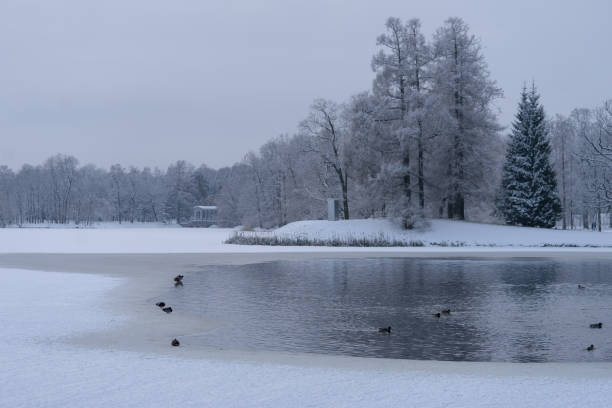
Ectothermic Adaptation is a type of Adaptation that occurs when the body’s temperature. Because of their ability to adjust to dramatic changes, fish in ponds can survive winter when they freeze. When ponds freeze, it never completely freezes. Even when temperatures dip considerably below zero, a pond’s ice will only form to a certain extent, leaving water around degrees Fahrenheit beneath it.
While humans cannot endure such freezing temperatures because the human body temperature drops rapidly. Fish can survive in cold water because they are ectothermic. It implies that fish have no control over their body temperature, which would be very near the water. The term “cold-blooded” is commonly used to characterize this phenomenon.
Metabolism slowed
A fish moving beneath a thick covering of ice has a metabolic rate that is significantly lower than in the other season. When the water gets colder, the fish’s core temperature drops too. As the waters are much warmer, fish slows down and not as fast as they are whenever the temperature is much more relaxed.
The fish requires significantly less energy to fish survive in the cold water, which would be a good thing because there isn’t as much food accessible to them under the ice in the winter as there is in the summer. Eels and catfish are recognized to wait for spring by burrowing in the soil at the pond’s bottom.
Obtaining Food
Some fish species will continue to feed on anything they may find. Crappies, perch, bluegills, pickerel, and trout have evolved to elevate their body temperatures even in freezing water, but they must eat to sustain this accomplishment. Bigger fish will consume smaller fish and will catch whatever baitfish are left in the pond, but smaller fish survive cold water and will have to rely on other food sources.
As the weather warms, the tips of any weeds trapped in the ice are pushed on as the water seeps back through the ice, causing it to rise and float. This can pull weeds out of the mud at their roots and agitate aquatic insects, making them easy prey for hungry fish.

